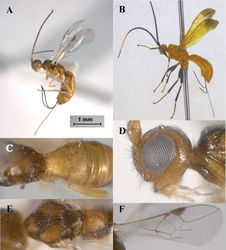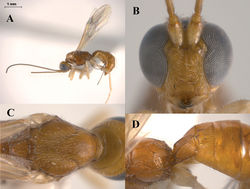Maintenance
All wikis at Biowikifarm are in read-only mode due to the restoration after a severe cyberattack in October 2023.
After 1 year being shut down the Biowikifarm is online again.
You see the latest restored version from 18th October 2023.
Heerz
| Notice: | This page is derived from the original publication listed below, whose author(s) should always be credited. Further contributors may edit and improve the content of this page and, consequently, need to be credited as well (see page history). Any assessment of factual correctness requires a careful review of the original article as well as of subsequent contributions.
If you are uncertain whether your planned contribution is correct or not, we suggest that you use the associated discussion page instead of editing the page directly. This page should be cited as follows (rationale):
Citation formats to copy and paste
[Expand] |
Ordo: Hymenoptera
Familia: Braconidae
Name
Heerz Marsh – Wikispecies link – Pensoft Profile
- Heerz Marsh, 1993: 17; Marsh 2002[1]: 102.
Type species
Heerz lukenatcha Marsh
Diagnosis
Heerz distinguishes from other doryctine genera by the following combination of features: (1) frons excavated (Fig. 2D), (2) propodeum with a longitudinal median carina followed by a pentagonal areola (Figs 2C, 3D), (3) second metasomal tergite entirely or partially sculptured, contrasting with third one, which is smooth, polished and with a transverse furrow (Figs 2C, 3D), (4) vein r-m of fore wing present (Fig. 2F), (5) vein M+CU of hind about as long as vein 1M, (6) vein cu-a of hind wing straight or slightly curved apically towards wing apex, (7) male hind wing without pterostigma, and (8) hind coxa with a distinct basoventral tooth. Species of Heerz are very similar in habitus to those of Lissopsius, all having a body mostly smooth and shiny, propodeum with a longitudinal median carina followed by a pentagonal areola, and vein M+CU of hind wing slightly shorter to larger than vein 1M. However, Heerz differs from Lissopsius by having the vein r-m of fore wing present (Fig. 2F) (absent in Lissopsius), hind coxa with a basoventral tooth (absent in Lissopsius), and ovipositor distinctly sclerotised apically (uniformly slcerotised in Lissopsius).
Description
Small to moderate size, 2.5-7.0 mm; eyes large, moderately to distinctly emarginated opposite antennal sockets; frons concave; occipital carina present, meeting hypostomal carina before mandible; labrum distinctly concave; hypoclypeal depression small and round; clypeus short; malar suture absent; maxillary palpi 5-segmented, labial palpi 4-segmented; head and mesosoma smooth or weakly sculptured; mesoscutum declivous anteriorly; prepectal carinae present; precoxal sulcus smooth; surface of propodeum smooth on anterior half, slightly rugose on posterior half, with a median longitudinal carina followed by a pentagonal areola; metapleural flange present; fore tibia with a row of spines along anterior edge; hind coxa with a distinct basoventral tooth; vein m-cu of fore wing antefurcal to vein 2RS, thus (RS+M)b present; vein 1cu-a postfurcal to vein 1M; vein r-m of fore wing present; second submarginal cell distinctly short; first subdiscal cell of fore wing open at apex; vein M+CU of hind wing slightly shorter to larger than vein 1M; males without pterostigma on hind wing; basal sternal plate (acrosternite) of first metasomal tergite short, 0.2-0.3 times the length of tergum; first and second metasomal tergites scupltured; third metasomal tergite smooth with a transverse furrow; remaining metasomal tergites smooth; ovipositor strongly sclerotised apically; nodes reduced, only one or absent.
Distribution
Brazil, Costa Rica and Mexico.
Remarks
The two new species of Heerz described below considerably modify the previous concept of the genus. The two previously described species, Heerz lukenatcha and Heerz tooya Marsh, are characterised by their smooth mesosoma, dusky wings and relatively large body size. The Mexican species, on the other hand, have a coriaceous mesoscutum, uniformly hyaline wings and are considerably smaller, especially Heerz ecmahla. Moreover, frons excavation is more conspicuous in the two new species compared to Heerz lukenatcha and Heerz tooya. Despite these morphological differences, our comparisons with type material and our DNA sequence data (see below) led us to include the new species within Heerz.
Key to described species of Heerz (modified from Marsh 1993[2])
Taxon Treatment
- Zaldívar-Riverón, A; Martínez, J; Ceccarelli, F; Shaw, S; 2012: Five new species of the genera Heerz Marsh, Lissopsius Marsh and Ondigus Braet, Barbalho and van Achterberg (Braconidae, Doryctinae) from the Chamela-Cuixmala biosphere reserve in Jalisco, Mexico ZooKeys, 164: 1-23. doi
Other References
- Jump up ↑ Marsh P (2002) The Doryctinae of Costa Rica (excluding the genus Heterospilus). Memoirs of the American Entomological Institute 70: 1-319.
- ↑ Jump up to: 2.0 2.1 Marsh P (1993) Contributions of the American Entomological Institute 28: 1-58.
Images
|




